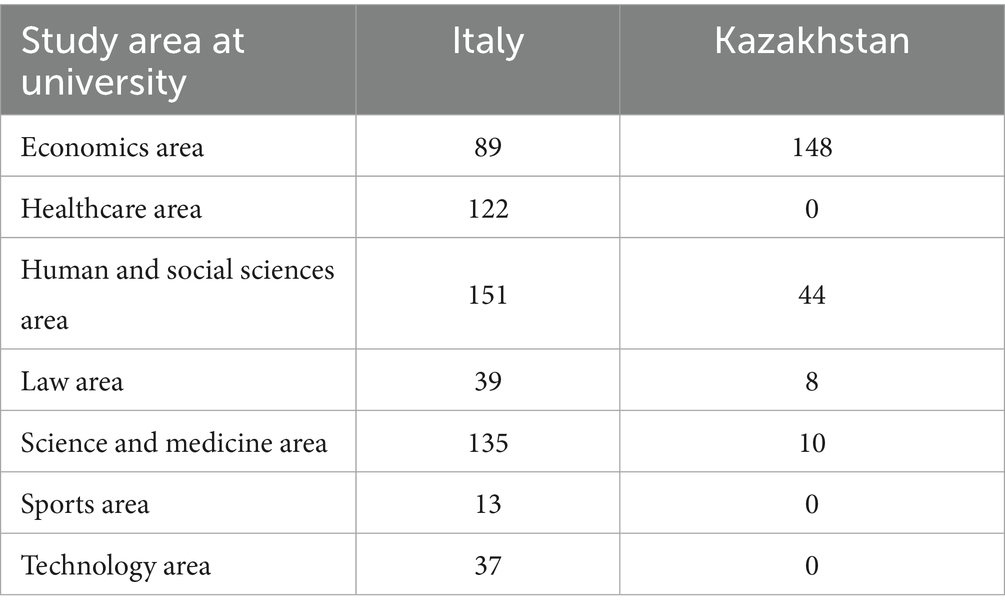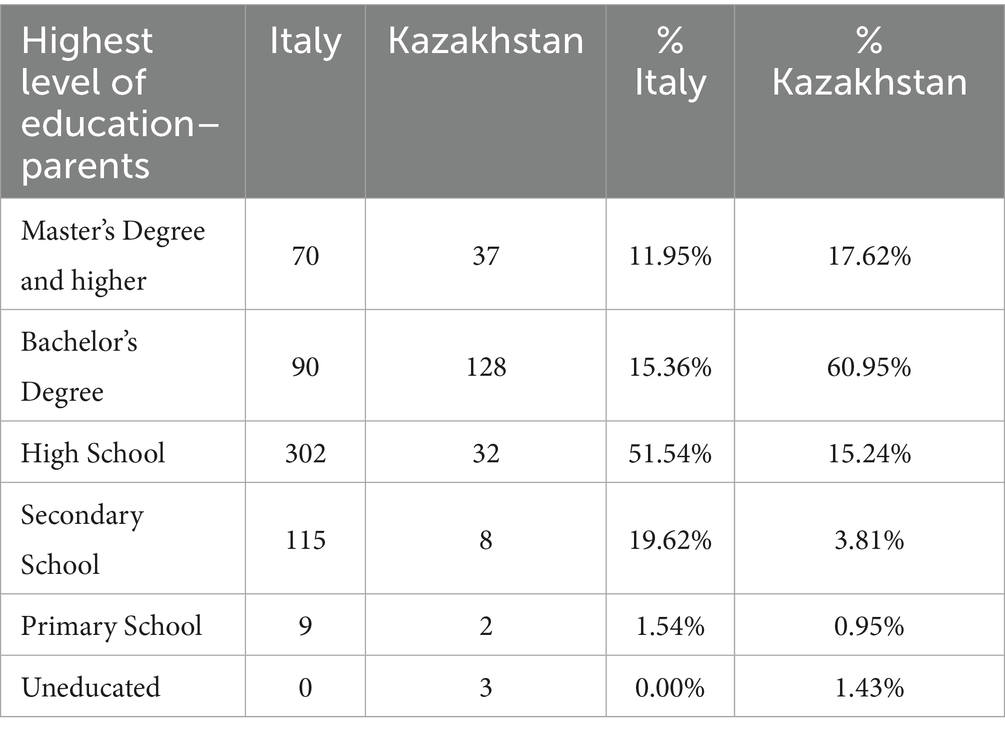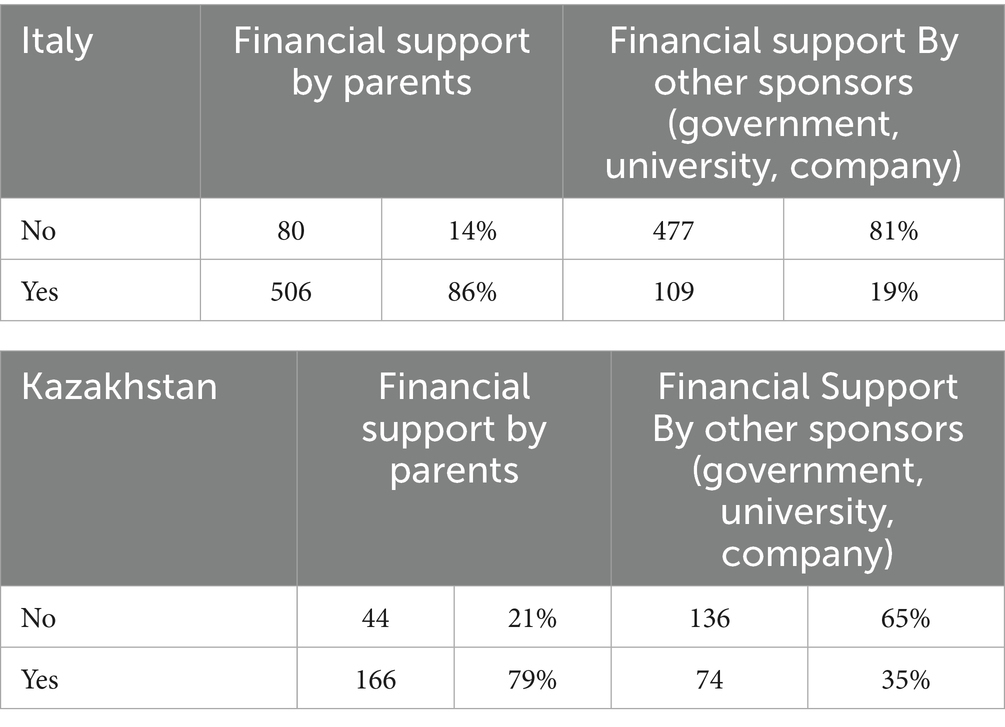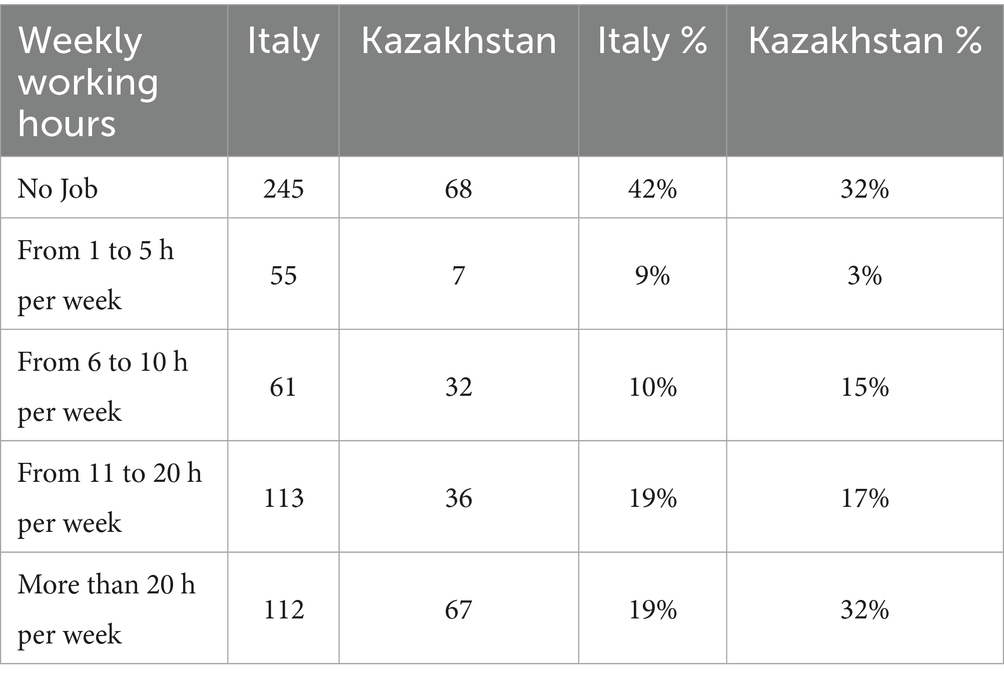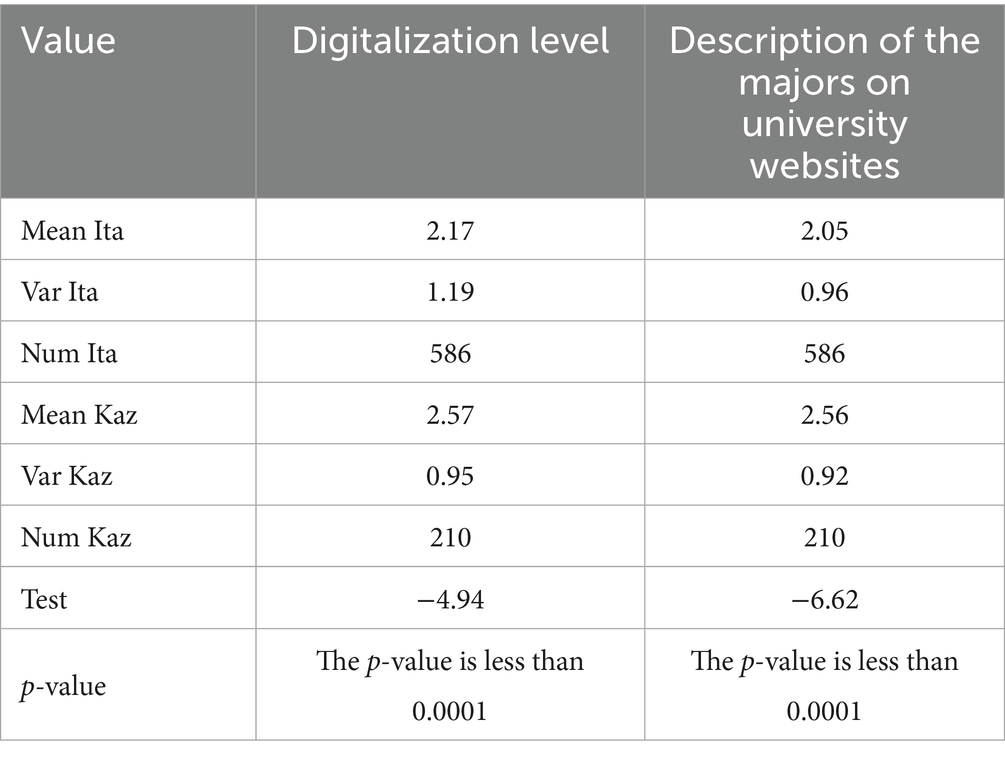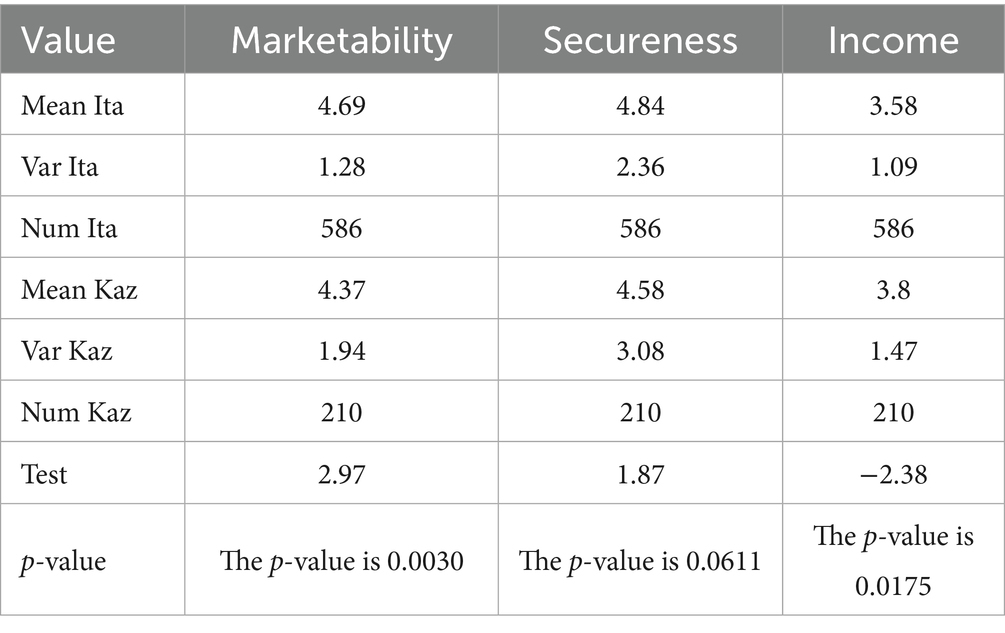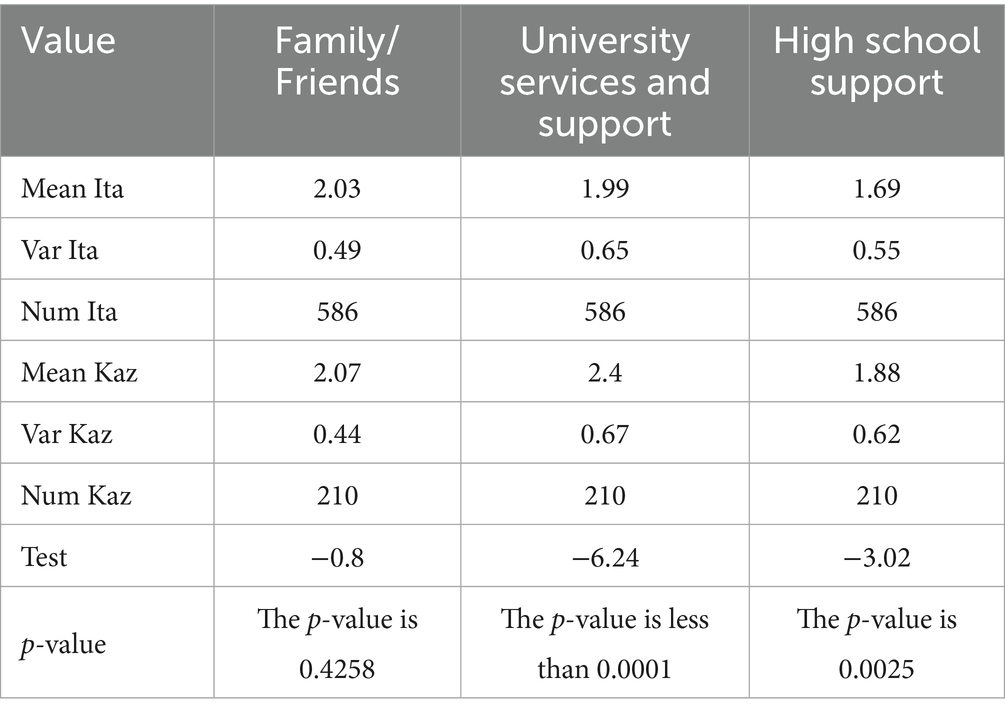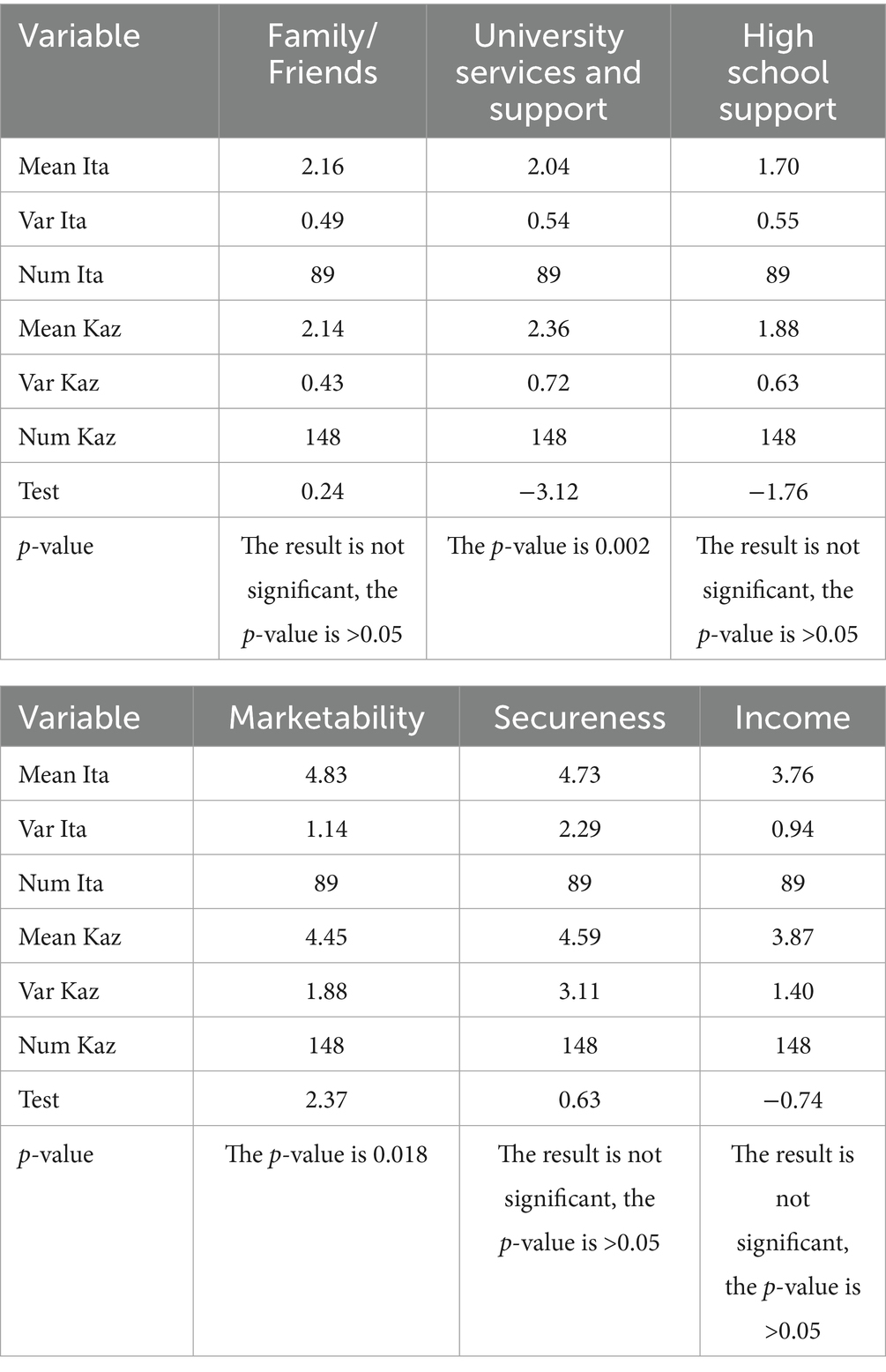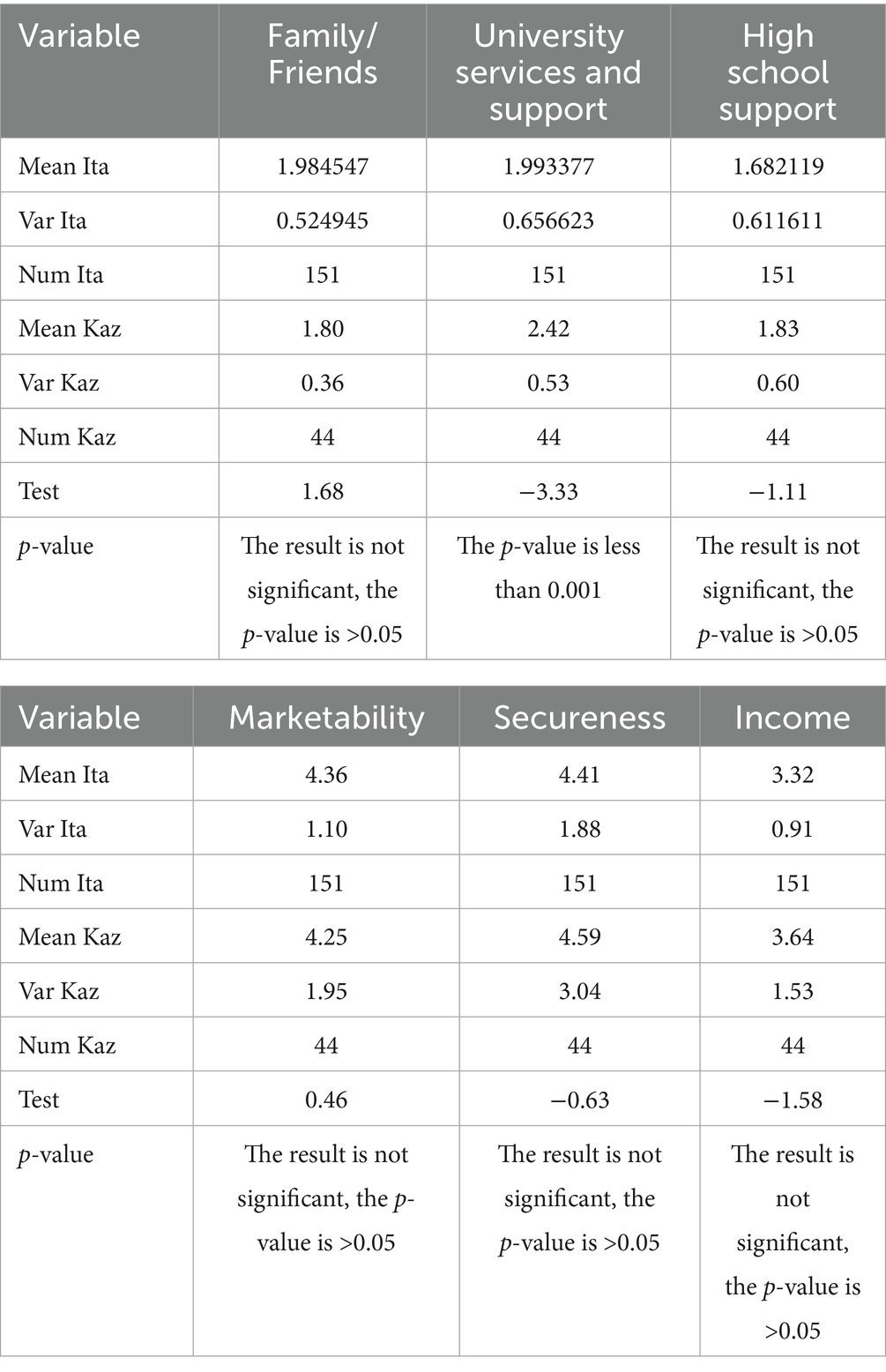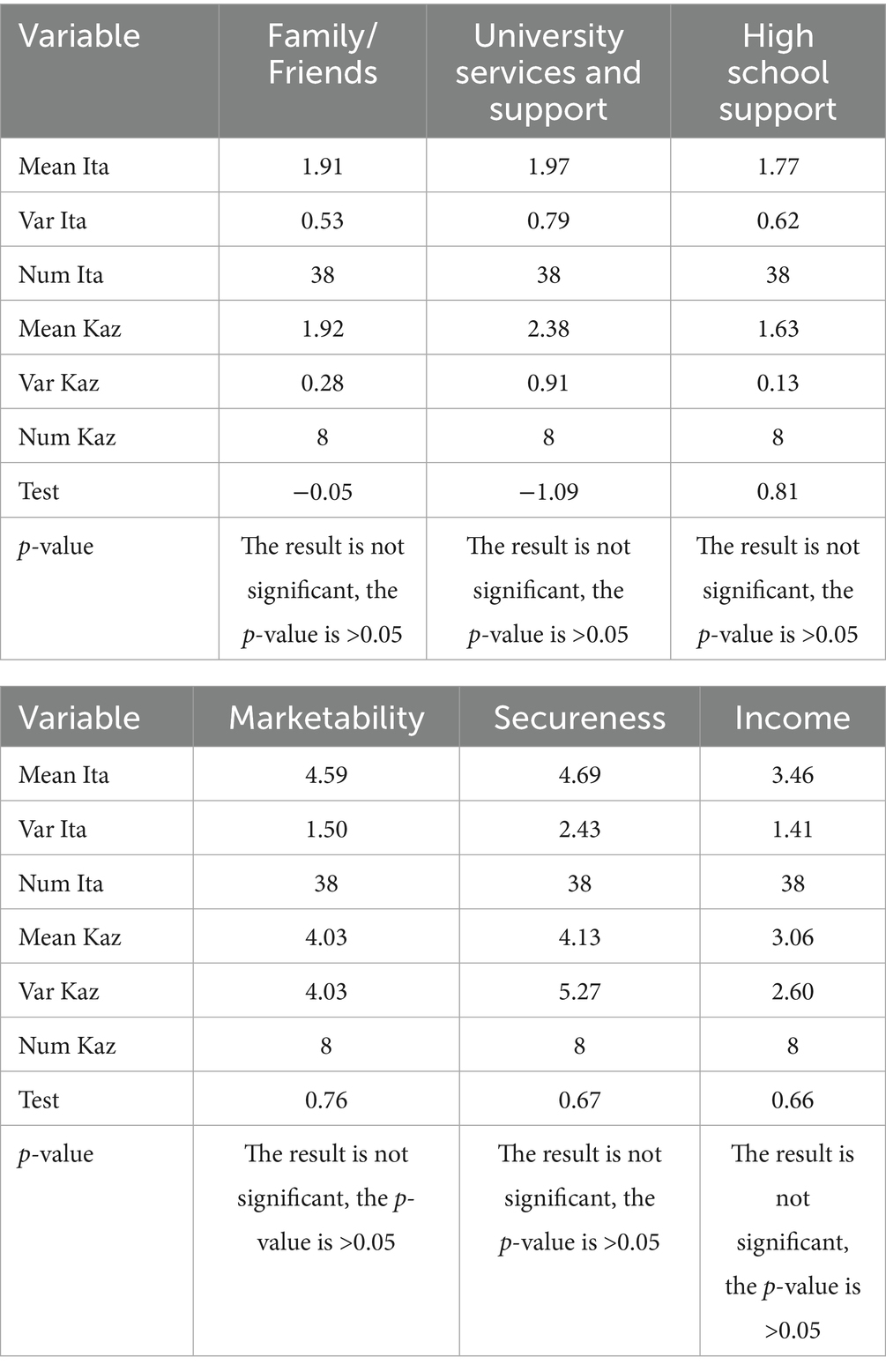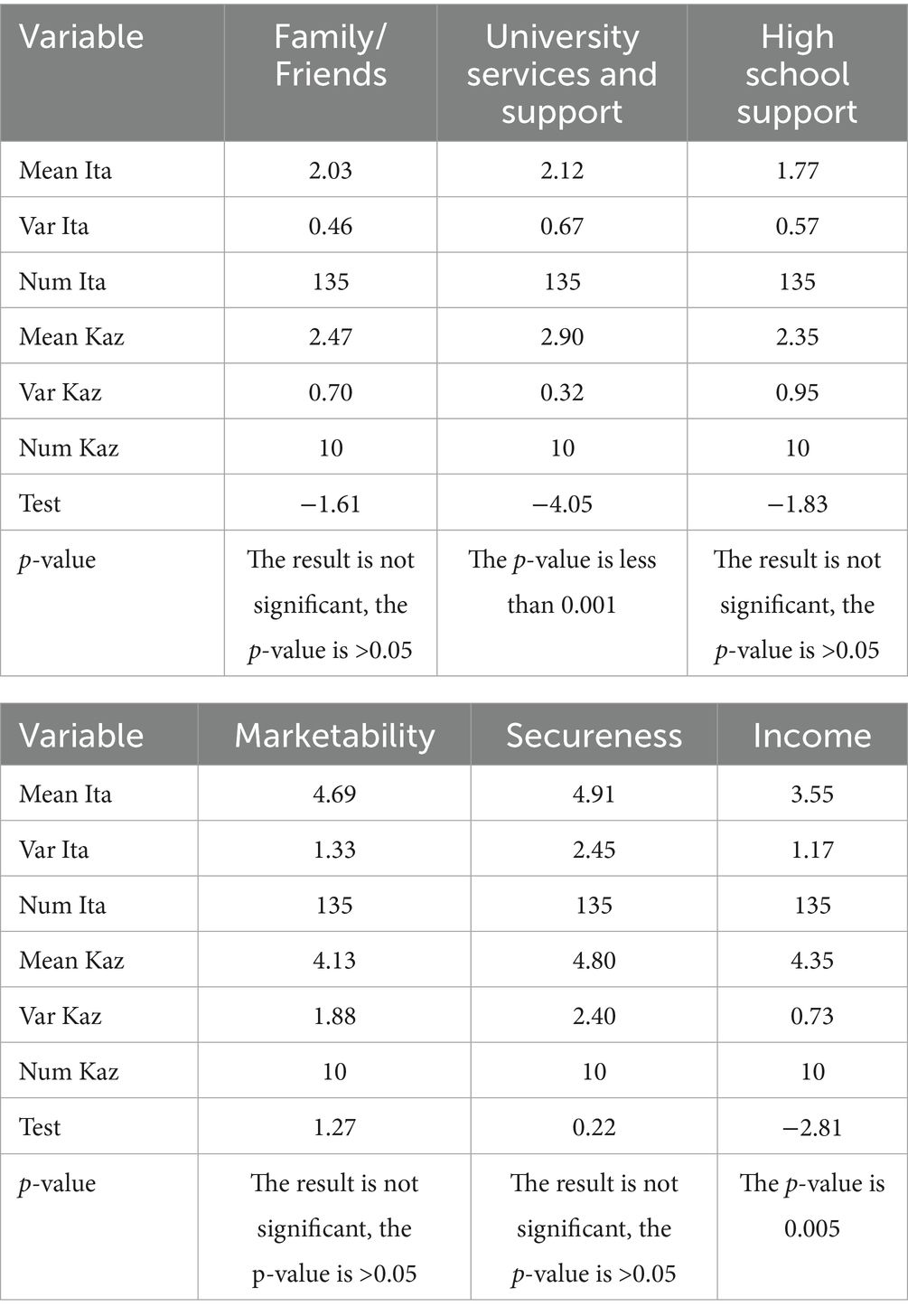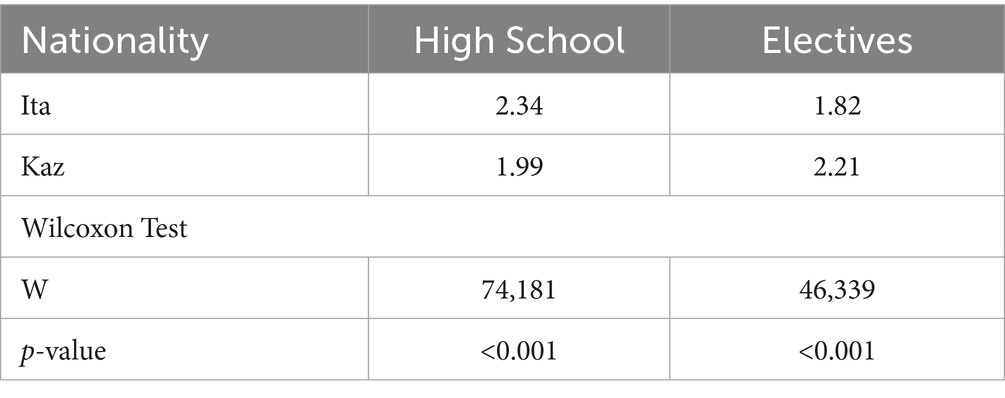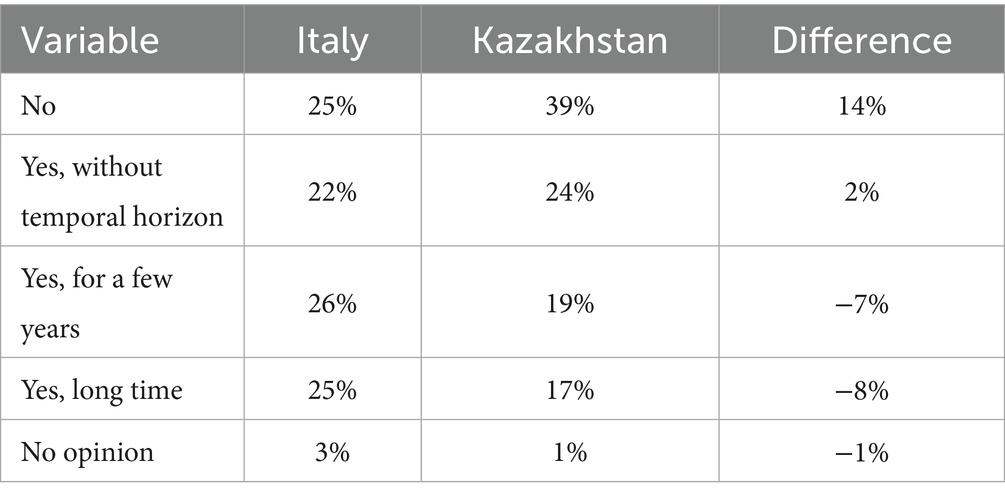- 1Department of Law, Economics, and Culture, University of Insubria, Como, Italy
- 2Kenzhegali Sagadiyev University of International Business, Almaty, Kazakhstan
The choice of a university major significantly impacts students’ professional trajectories. Despite its importance, limited research compares the factors influencing major choice among students in different cultural contexts, such as Italy and Kazakhstan. This study explores the primary motivations influencing Generation Z students’ selection of academic majors in these countries. Utilizing a survey administered to approximately 800 respondents in Italy and Kazakhstan, the research examines factors including perceived academic experience value, financial incentives, social proof and influence networks, intellectual motivations, the perceived impact of digital marketing tools, and the impact of the COVID-19 pandemic. The findings provide insights into the similarities and differences in decision-making processes among students in these countries, contributing to a deeper understanding of how cultural, economic, and marketing factors shape educational choices.
Introduction
Selecting an academic major is one of the most pivotal decisions in a student’s educational journey, profoundly impacting future career paths, economic prospects, and personal fulfilment. This decision entails substantial time, intellectual effort, emotional commitment, and financial investment (Sylaska and Mayer, 2024). An academic major not only dictates the courses and content a student engages with but also influences their peer group, faculty interactions, and ultimately, their professional trajectory post-graduation (Lacey et al., 2020). The choice of major is intrinsically linked to labor market outcomes, affecting future earnings, job satisfaction, and career advancement opportunities (Kim et al., 2015). Studies have shown that certain majors lead to higher economic returns (Haller and Portes, 2019), influencing students to consider potential earnings in their decision-making processes (Nguyen et al., 2023). Conversely, a mismatch between a student’s major and their interests or abilities can lead to dissatisfaction, increased stress, and a higher likelihood of dropping out (Ahmed et al., 2017). This decision is particularly complex for Generation Z, whose unique digital orientation and global exposure shape how they gather information and form preferences. Yet, despite its significance, existing research offers limited insight into how these decisions are made in non-Western context (Calkins and Welki, 2006; Hastings et al., 2015; Ehlert et al., 2017; Baker et al., 2018). Despite the critical importance of academic major selection, existing literature has predominantly focused on Western contexts, particularly the United States, leaving significant gaps in understanding how these decisions are shaped in non-Western settings such as Kazakhstan and European Italy. This gap is significant, considering cultural values, educational structures and familial expectations uniquely influence major selection in these contexts. In Kazakhstan, high school students often need more awareness of potential career paths, leading to uninformed major choices post-graduation (Tazhina et al., 2017). While some research has addressed factors affecting female students’ decisions to pursue STEM majors (Almukhambetova and Kuzhabekova, 2020), comprehensive studies on the broader student population remain limited. There is limited understanding of how such incentives operate in post-Soviet or Southern European socio-economic contexts, where financial norms and access to resources markedly differ. First, it assists educational institutions in tailoring programs and marketing strategies to meet the needs and preferences of this demographic. Second, it provides insights for policymakers and businesses to anticipate labor market trends and prepare for future workforce demands. Lastly, it contributes to the academic discourse by filling a gap in the literature regarding non-Western contexts. The process of choosing a major varies significantly across educational systems. In Kazakhstan, the selection begins with the Unified National Test (UNT), where students choose subject bundles that determine their eligible majors at the university level (Minister of Education and Science of the Republic of Kazakhstan, 2017). This system contrasts with the more flexible structures in countries like the United States, where students often select courses that eventually shape their majors (Jabbar et al., 2020). In Kazakhstan, once a major is selected, course choices are typically predefined, offering limited flexibility—a factor that may influence students’ satisfaction and engagement with their studies. Therefore, this study focuses on two contrasting national contexts – Kazakhstan and Italy – to examine how cultural norms, financial considerations, digital influence, and intellectual motivations affect Gen Z’s academic choices. By identifying and comparing these determinants, the research aims to provide an understanding of what drives major selection in diverse socio-economic and educational systems.
In this work is explained how Generation Z students in two contrasting higher-education contexts transform personal, social, and economic cues into a concrete major choice. By comparing Italy – a mature, reputation-driven system – with Kazakhstan – a rapidly modernizing, test-driven system – and it is shown which decision drivers are culturally contingent and which appear universal. The comparison offers (1) university evidence for tailoring recruitment messages to different cultural logics, (2) policy-makers guidance on where financial or informational interventions will yield the greatest equity gains, and (3) researchers a benchmark dataset that extends the still Western-centric literature on academic-choice behavior. This research is organized into four main sections. It begins with a comprehensive review of the existing literature on the topic. This is followed by the methodology section, which outlines the approaches and tools used in the research. The third section presents the data analysis and findings. The study concludes with a discussion of the implications of the results and final considerations.
Literature review and context
Gen Z is now entering higher education and making career-defining choices in very different national contexts. Comparing Kazakhstan and Italy offers a contrast in how economic realities, cultural values, and educational systems shape Gen Z students’ academic major selection. Kazakhstan is an upper-middle-income, resource-oriented economy in post-Soviet transition whose universities allocate state-funded places almost exclusively through a single high-stakes examination – the Unified National Test (UNT) (Baikenov, 2025). Italy, by contrast, is an advanced European economy with a more flexible university system. Labor-market prospects diverge just as sharply. In 2024 Kazakhstan recorded a youth (15–34) unemployment rate of 3.1%, one of the lowest in the OECD/Eurasia region (The situation on the labor market 2024, 2025), while Italy’s equivalent rate for early 2025 hovered near 19%, despite a historically low headline jobless rate of 6% (Cinelli, 2025). Between 2022 and 2024 Kazakhstan’s labor force expanded from 9.43 million to 9.66 million people, and employment followed suit, rising from 8.97 million to 9.21 million; most of the increase came from wage-earners, whose ranks grew from 6.85 million to 7.02 million, while self-employment held steady at just over 2.19 million. In Kazakhstan, labor-market outcomes for Generation Z have strengthened in recent years but remain uneven across educational levels and regions. Administrative tracer data show that 79.5% of university graduates were in employment within a year of finishing their degrees in 2022, up from 71% in 2020 and edging above 81% in 2024 (Atameken National Chamber of Entrepreneurs, n.d.). By comparison, the overall employment rate for young adults with only upper-secondary schooling is estimated at roughly 65–67% - a gap that has narrowed by about 3 percentage points since 2020 as employers expand entry-level hiring (APCDA, 2025). At the macro level, the youth unemployment rate fell to 3.1% in 2024 and NEET prevalence to 6.5%, among the lowest figures in the OECD-Eurasia region (The situation on the labor market 2024, 2025). Regional disparities, however, mirror Italy’s north–south divide: graduate-age employment in Almaty city approaches 90% whereas the Ulytau, North Kazakhstan and Zhetysu regions lag by nearly 20 percentage points (Ismailov, 2025). Early school-leaving remains limited (4.4% of primary-age children out of school), yet tertiary gross enrollment is 56.5%, below the EU average, which constrains the pool of high-skill talent and partly explains why Kazakhstan’s graduate employment rate still trails the OECD benchmark of 88% 1-to-2 years after graduation (Trading Economics, n.d.). Taken together, the data indicate that while a university degree confers a clear labor-market premium, policy efforts must now focus on boosting tertiary participation in slower-growing regions and aligning degree specializations with high-demand sectors to sustain these gains. Considering Italy, in 2022, among individuals under the age of 35 who had obtained a qualification between 1 and 3 years prior, the employment rate increased: 56.5% for upper secondary graduates and 74.6% for university graduates (+6.6 and +7.1 percentage points compared to 2021). Among graduates, the rate exceeds by four points the level recorded prior to the 2008 financial crisis. However, substantial gaps persist compared to European averages. In Southern Italy, the employment rate for graduates aged 30–34 is 69.9%, nearly 20 percentage points lower than in the North (89.2%). Early school leaving and low tertiary attainment are more common among youth with less-educated parents. From 2021 to 2022, employment rates rose by 1.3 percentage points for those with tertiary education and by two points for those with lower educational attainment. As a result, the employment gap between graduates and non-graduates slightly narrowed. Nonetheless, Italy’s employment opportunities remain below the EU average, even for university graduates (ISTAT, 2023).
Selecting an academic major is a critical decision that significantly influences students’ educational experiences and future career trajectories. This choice is affected by a complex interplay of factors, including perceived academic experience value, financial incentives, social proof and influence networks, intellectual motivations, the level of digitalization (e.g., University website with course catalogs and basic information; Virtual campus tours; Interactive orientation webinars), and, more recently, global events such as the COVID-19 pandemic. While extensive research has been conducted in countries like the United States (Calkins and Welki, 2006; Zhang, 2007; Hastings et al., 2015; Baker et al., 2018), there is a notable gap in studies focusing on Generation Z students in Kazakhstan and Italy. This literature review synthesizes existing research related to these factors influencing major choice.
Perceived academic experience value
Perceived academic experience value – the subjective benefits students attribute to theory chosen field of study – serves as a critical mediator between institutional offerings and Generation Z’s educational trajectories. In Italy and Kazakhstan, this construct manifests divergently, reflecting contrasting cultures of intellectual simulations, personal growth and career alignment. For example, Italian universities increasingly integrate project-based learnings and internships to enhance perceived value in applied fields (Ćwiertniak et al., 2022) that might lead to gaining more academic experience. Students more likely to choose majors that align with their interests and perceived strength (Calkins and Welki, 2006; Umarji et al., 2023). The perspective through gender patterns shows that women constitute 73% of psychology majors, often described the field as a “lens for self-understanding and societal impact” (Osterhage et al., 2024).
Similarly, Brown et al. (2021) emphasized the role of intrinsic interests in career-related decisions. In the digital era, availability of comprehensive, engaging information on university websites, virtual campus tours, and online course previews substantially enhances students’ perception of academic value (Kahu and Nelson, 2017). The level of digitalization within educational programs plays an increasingly important role in the decision-making processes of Generation Z students. Generation Z (born ~1995–2012) is often described as the first cohort of true digital natives – individuals who have grown up immersed in computers, smartphones, and the internet from birth (Seetha Lakshmi and Jayakani, 2025). Unlike representatives of prior generations, Gen Z has constant access to digital technology, which has profoundly shaped their skills and behaviors. They are accustomed to instant information retrieval and continuous connectivity (Reid et al., 2023). In fact, this unprecedented global connectivity means Gen Z students can easily reach and evaluate diverse information, experiences, and opinions online (Karaman and Efeoğlu, 2022). Being digital natives, they naturally turn to online resources and social networks when weighing educational options. For example, Anderson and Anderson (2024) study noted that as Generation Z students consider which university to attend, social media engagement has become an increasingly important part of the digital decision set. Factors such as the availability of online resources, the integration of technology within courses, and digital infrastructure—including a standardized online presence through social media or a website, and tools like virtual campus tours—can significantly impact the perceived value of a major.
Financial incentives and constraints
Financial incentives encompass both the financial support received to pursue higher education and the anticipated economic returns after graduation. These financial considerations are direct outcomes that students evaluate. A major perceived to offer higher economic returns or better financial security fosters a more positive attitude and stronger intention to pursue it. This aligns with a consumer’s cost–benefit analysis of a product, where financial viability is a key determinant of purchase intention. This includes assistance from parents or sponsors and expectations regarding marketability, job availability, job security, and starting salary. Several studies have documented the influence of financial incentives on major choice. Wiswall and Zafar (2021) found that expected earnings significantly impact students’ major selection decisions. Yi and Park (2024) suggested that perceived long-term earnings associated with particular study can substantially impact students’ preferences, often leading them to prioritize majors that are linked to higher income and job security. Recent research also highlights that parental financial support is motivated by a desire to fulfil parental responsibilities and ensure their children’s long-term success, regardless of the child’s gender (Svynarenko, 2019). Moreover, family income and parental education levels are strongly linked to educational attainment, influencing both access to higher education and post-graduation outcomes (Witteveen and Attewell, 2020; Li et al., 2023). On the other side it is important to understand which are the possible financial and parental constraints in this field. In Italy, financial constraints typically involve high living costs in university cities (Petruzzellis and Romanazzi, 2010), while Kazakhstan students face challenges with tuition affordability and regional economic disparities. Parental involvement in Italy is influential but balanced with student autonomy, whereas Kazakh families often make collective decisions with stronger parental direction (Nurbayev, 2021; Chankseliani et al., 2020).
Social proof and influence networks
Social proof and influence networks encompass the impact of societal factors and close relationships on students’ choices of academic majors. This concept directly operationalizes the “subjective norms” component. The perceived social pressure from family, friends, and institutional recommendations (university support, high school guidance) influences a student’s belief about whether important others approve of their major choice, thereby shaping their behavioral intention. This reflects how social validation, a core marketing principle, directly impacts an individual’s perceived social desirability of a choice within the TRA framework. Within this context, social proof constitutes a psychological and marketing phenomenon describing how individuals replicate the actions or choices of others under the presumption that such actions indicate appropriate behavior or optimal decision-making (Goedegebure, 2019). More precisely, individuals employ collective behavior as substantiation of advantageous choices. This influence mechanism typically diminishes perceived risk: observing numerous peers adopting a product, service, or decision enhances an individual’s confidence in making similar selections (Kembau et al., 2024). As digital natives, Generation Z demonstrates heightened susceptibility to peer perspectives, online evaluations, and influencer trends (Kembau et al., 2024). To illustrate, a Generation Z student may experience increased assurance when selecting a particular academic discipline if it demonstrates popularity among social connections or receives endorsement from esteemed figures within social media environments—the widespread approbation functions as social proof validating the appropriateness of the choice. This tendency results in universities and commercial entities frequently highlighting student testimonials, alumni achievement narratives, and community popularity to leverage social proof in guiding Generation Z’s decision-making processes. These factors include the type of high school attended, parental education levels and encouragement, peer recommendations, gender representation within faculties, media influences, advice from friends, the approachability of university faculty, and guidance from teachers and counsellors. Research has demonstrated that peers and social networks play a significant role in shaping students’ educational choices (Zimmermann, 2020). In Italy, parental influence operates through a dual mechanism of cultural capital transmission and migration-driven pragmatism. Therefore, families in big cities as Milan and Rome influence their children to choose medicine, law and engineering majors, because these are perceived markers of social status (Singh and Ji, 2022). This ‘dynastic academy strategy’ reinforces class boundaries: 78% of medical students originate from families where at least one parent holds an advanced degree (Ali et al., 2020). The educational attainment and expectations of parents can profoundly shape students’ aspirations and perceptions of higher education (Raabe and Wölfer, 2018). Gender representation within faculties can influence major choices due to perceived gender norms and the presence of role models (Cheryan et al., 2017; Trout, 2021). The rise of social media has introduced new dynamics into the decision-making process, with influencers and media content swaying students’ perceptions and choices, particularly among Generation Z students who are highly engaged with social media platforms (Cooley and Parks-Yancy, 2019; Chang and Chang, 2023). Digital marketing tools refer to a range of online software, platforms, and technological channels that organizations use to plan, execute, and monitor marketing campaigns on the internet (Mejía-Trejo, 2021). These tools enable marketers to reach and engage target audiences through digital means. Common digital tools include social media networks, search engine marketing, email marketing, websites, and online video platforms (Sousa, 2024). Marketers use these tools to share content, personalize outreach, and build relationships at scale. Since Generation Z spends much of their free time online, such tools play a crucial role in shaping their consumer behavior and even their educational choices. Studies note that the effective use of social media, search engines, and email campaigns can significantly influence Gen Z’s decisions (Silva and Krikheli, 2024).
Intellectual motivations
Intellectual motivations are internal drives centered on curiosity, learning, and the intrinsic satisfaction gained from knowledge or problem-solving. The term “intellectual” motive is defined by authors as “the extent to which individuals are motivated because of need for learning and discovery.” Comprehensive and accessible information about majors can also facilitate informed decision-making (Zhang, 2007). Intellectual motivation is possibly inherently intrinsic – the process of thinking and learning is its own reward. For instance, research on student psychology describes intrinsic intellectual motivation as an emotional response to the content and process of intellectual learning, highlighting that people find enjoyment and fulfilment in learning for its own sake (Kamberi, 2025). When a Gen Z student chooses an academic major, intellectual motivation manifests as passion of a subject or love of learning beyond external rewards. Many Gen Z learners are driven by personal interest – they select a field of study because it genuinely fascinates them or aligns with their desire to develop expertise (Aryani and Umar, 2020). This kind of motivation is an internal factor in decision-making, studies have found that Gen Z is often more influenced by such internal factors (interest, personal values, academic satisfaction) than by purely external ones when deciding on a university major (Aryani and Umar, 2020).
Impact of the COVID-19 pandemic
The COVID-19 pandemic has introduced unprecedented challenges and uncertainties, potentially affecting students’ major choices (Birmingham et al., 2023; Rodríguez-Planas, 2022; Gómez-García et al., 2022; Velásquez-Rojas et al., 2022). Concerns about job security, shifts in labor market demands, and the transition to online learning may influence students’ decisions. Studies have begun to explore the pandemic’s impact on higher education. Aucejo et al. (2020) found that the pandemic affected students’ academic outcomes and future plans in the United States. In Europe, Marinoni et al. (2020) reported disruptions in educational activities and a shift towards online learning, impacting students’ experiences and potentially their major choices. The increased emphasis on digital skills and remote work may shift students’ preferences toward majors perceived as more adaptable to such environments (Chadha et al., 2021). Additionally, the pandemic may influence students’ perceptions of job stability and demand in various fields, altering their considerations when choosing a major. Given these considerations, this study seeks to explore the factors influencing Generation Z students’ choice of major in Kazakhstan and Italy. Specifically, the research question is: What factors most notably influence the choice of major among Generation Z students in Kazakhstan and Italy, and how do these factors differ between the two countries?
To address this question, we propose the following hypotheses:
H1: There is no significant difference between Italian and Kazakh Generation Z students in the perceived impact of digital marketing tools and online resources on their choice of major.
H2: Financial incentives are important factors that influence student decision-making. We hypothesize that financial considerations (such as perceived return on investment) do not differ significantly between students in Italy and Kazakhstan.
H3: Social proof, a major influencer in student behavior, is expected to have similar effects on the choice of majors among students in both countries.
H4: There is no significant difference between students in Italy and Kazakhstan regarding intellectual motivations, which can be viewed as product knowledge influencing student decisions.
H5: The COVID-19 pandemic can be likened to an external market disruption, affecting students’ choice criteria. We hypothesize no significant difference in how this disruption influences major choices in the two countries.
By examining the determinants of major choice among Generation Z students in Kazakhstan and Italy, this research contributes to the limited body of literature on this topic within these contexts. It provides valuable insights for universities aiming to attract and retain students by aligning their offerings with students’ motivations and expectations. Additionally, understanding these factors can help address issues such as student dissatisfaction, dropout rates, and misalignment between education and labor market needs.
Methodology and questionnaire structure
This study employed a quantitative research approach, collecting empirical data through questionnaires distributed to university students in Almaty, Kazakhstan, and Varese and Como, Italy. Students were recruited through university mailing lists, WhatsApp groups, and QR codes placed around university campuses. The questionnaire consisted of 7 thematic sections with 57 total items:
• Demographic and Educational Background (13 items)
• Factors Influencing Major Choice (22 items)
• Beliefs and Job Market Expectations (5 items)
• Satisfaction and Major Change History (5 items)
• University Merchandising Perception (8 items)
• COVID-19 Impact (2 items)
• Consent and Open Comments (2 items).
All evaluative sections (II, III, V, and VI) used a 5-point Likert Scale (1 = Strongly Disagree to 5 = Strongly Agree). Open-ended questions were included to gather detailed responses regarding major satisfaction, changes in academic path, and final comments. The questionnaire, administered via Google Forms in early 2023, was available in two languages to accommodate Russian-speaking respondents, ensuring better comprehension and increased participation across both countries. Before the spread of the questionnaire, it was conducted a pretest with 15 participants—a mix of Italian and Kazakh students. They completed the questionnaire while providing feedback on each question, highlighting potential comprehension issues and suggesting improvements. Their valuable input allowed us to refine several minor aspects of the questionnaire before its actual administration to the final sample.
The study’s methodological design, particularly the structure of the questionnaire, is explicitly grounded in The Theory of Reasoned Action (TRA), as indicated by Figure 1. The TRA posits that an individual’s behavioral intention is the most immediate determinant of their actual behavior. This intention is, in turn, influenced by two primary components: (1) the individual’s attitude towards performing the behavior (shaped by their beliefs about the outcomes of the behavior and their evaluation of those outcomes), and (2) subjective norms (perceived social pressure to perform or not perform the behavior, influenced by beliefs about what important others think and motivation to comply with those beliefs).
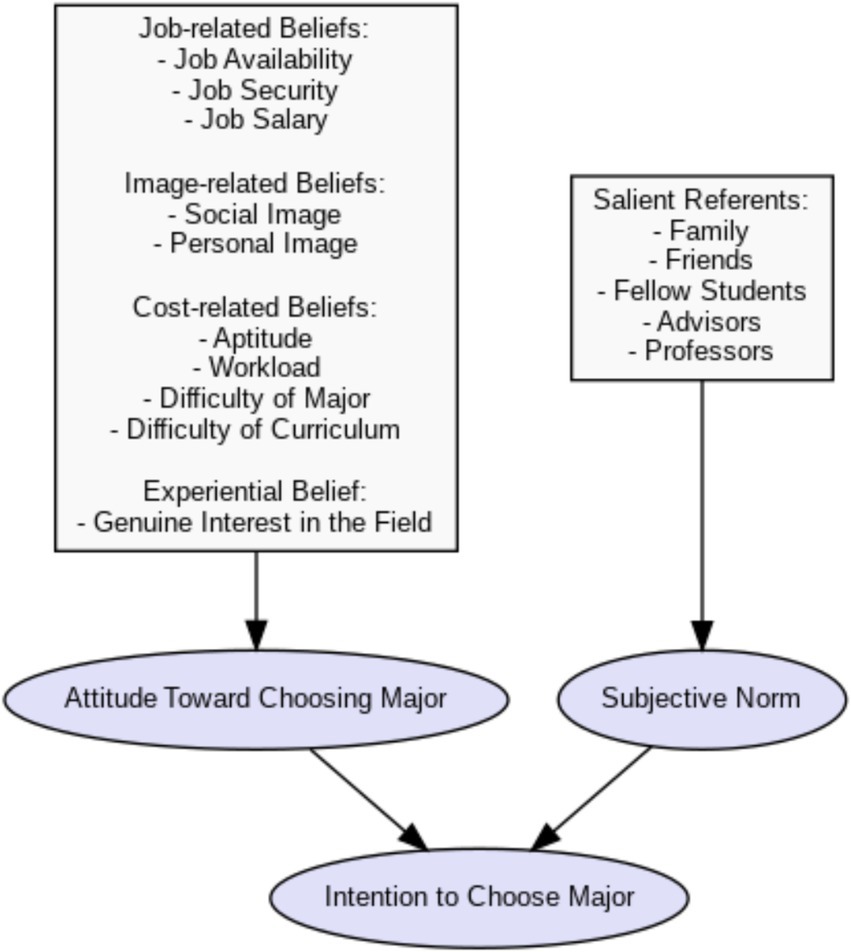
Figure 1. The theory of reasoned actions framework used in questionnaire (Zhang, 2007).
Methodologically, the primary techniques of descriptive and inferential statistics were used. For the inferential component, the z-test for difference between means and the Mann–Whitney test were employed when data non-normality was detected. For more information about these tests, readers are referred to Sirkin (2005). Hypothesis testing was conducted to examine the statistical significance of the identified factors, enabling a comparative analysis between Italy and Kazakhstan. This comparison aimed to determine whether differences existed between the two countries regarding factors influencing major selection and their impact on future career aspirations. From a software perspective, data processing was performed using Excel and R Studio and for more detailed information about R Studio, readers are referred to Jones et al. (2022).
Descriptive statistics
The study involved a total of 796 university students from two distinct geographical and cultural contexts: Italy (University of Insubria, Varese - Como) and Kazakhstan (University of International Business named after Kenzhegali Sagadiyev, Almaty). Our study employed a convenience sampling approach rather than probability sampling methods. Participants were recruited directly from the accessible university student population through institutional channels and campus outreach. This pragmatic approach allowed us to gather responses from a diverse cross-section of students while acknowledging the limitations in statistical generalizability (Golzar et al., 2022; Scholtz, 2021).
The Italian sample consisted of 586 students, of whom 368 were female, 216 were male, and 2 opted not to disclose their gender. The average age of the Italian participants was 21.56 years, representing a diverse group in terms of both gender and age. In contrast, the Kazakhstani sample included 210 students, with a higher proportion of females (154) compared to males (96), and an average age of 19.21 years.
The respondents’ chosen fields of study, divided by country, are presented below:
The data presented in Table 1 provides an overview of the respondents based on their chosen field of study, divided by country. However, the numbers are not perfectly comparable between Italy and Kazakhstan due to differences in the characteristics of the universities involved. For example, Italy has a broader representation across a variety of study areas, including healthcare, sports, and technology, which are absent in the Kazakhstani sample. This discrepancy suggests that the institutions participating in the study from each country offer different academic programs, which may influence the distribution of students across fields and impact the analysis of factors influencing major selection. Shifting on the level of study, a huge number of the respondents were undergraduate students as shown in the next table (Table 2).
To better describe the sample of respondents, they were also asked about the type and level of university studies they had pursued. In the previous table there is the description of the respondents. The sample is predominantly composed of undergraduate students, and the number of PhD students is too small to be statistically significant. However, it was decided to include PhD students as, under Italian regulations, they are still considered students in every respect.
Another question focused on the type of high school attended by students in both countries. As shown in the table (Table 3), there is a predominance of students coming from public schools.
Subsequently, Table 4 highlights significant differences in parental education levels between Italy and Kazakhstan. In Kazakhstan, many parents (61%) hold a bachelor’s degree, compared to only 15% in Italy. Conversely, over half of the Italian parents (52%) have a high school diploma, whereas this figure is much lower in Kazakhstan (15%). This is a relevant finding for this sample, there is a huge difference in the parents’ background.
Moreover, Table 5 highlights some disparities in the sample concerning financial support. In fact, both students in Italy and Kazakhstan receive financial assistance with slight differences and, concerning this situation, in Italy, a significant majority (86%) of students rely on parental support, while only 14% do not. However, a small number of Italian students (19%) also benefit from external sponsorships, including government grants, university scholarships, or corporate funding. In contrast, while 79% of Kazakh students also receive parental support, their support on external financial sponsorships is slightly lower at 35%.
Considering the employment status of the respondents, it is shown that Kazakh students were more involved in the workforce.
The final aspect of the descriptive analysis of the sample relates to the students’ employment status. In the previous table (Table 6), it can be observed that the values are quite similar, except for the category of more than 20 h per week, which indicates a slightly different situation. Kazakh students, in particular, seem to be more involved in the workforce, with a notable percentage working at least part-time while pursuing their university studies.
In the next section, the proposed hypotheses from the first part of the study will be analyzed from a differential perspective.
Inferential analysis
This section presents the analysis of hypotheses using statistical tests based on the questionnaire responses and the analyses are conducted comparatively, with statistical tests designed to determine whether responses to hypothesis-related questions are statistically similar or different between the two countries. Hypothesis H1 evaluates whether there is a significant difference between Italian and Kazakh Generation Z students in the perceived influence of digital marketing tools, as explicated in the previous paragraph, and online resources on their choice of academic majors. To evaluate this hypothesis, the questionnaire included questions designed to capture these intrinsic motivations, especially as they pertain to Generation Z students’ education (Albadi and Zollinger, 2021).
The results, presented in Table 7, indicate that the mean values for Italian students were 2.17 for digitalization level and 2.05 for the quality of descriptions, with variances of 1.19 and 0.96, respectively. For Kazakh students, the mean values were higher, at 2.57 and 2.56, with variances of 0.95 and 0.92. Statistical testing revealed significant differences between the two groups, with test statistics of −4.94 and −6.62 and p-values less than 0.0001, indicating a highly significant result.
These findings suggest that Kazakh students place a greater emphasis on digitalization and detailed online information when selecting their majors, compared to their Italian counterparts. For Generation Z students majors that incorporate advanced technology and provide engaging, easily accessible online information enhance their passion for the subject and intellectual satisfaction (Chang and Chang, 2023). The Self-Determination Theory affirm that intrinsic motivation – driven by curiosity, the pursuit of knowledge, and the enjoyment of learning for its own sake – flourishes when students’ basic psychological needs for autonomy, competence, and relatedness are fulfilled (Holzer et al., 2022; Hu et al., 2022). These insights underline the importance of digital marketing strategies and robust online content in influencing academic decisions across cultural contexts. Therefore, universities that effectively leverage digital platforms and offer detailed online content can significantly foster intrinsic motivation, aligning academic programs with students’ personal interests and values, and thereby influencing their major selection. The evaluation of hypothesis H2 on financial motivation was conducted in two distinct phases. The first phase focused on financial support provided by family members and/or institutions. As previously discussed in the descriptive analysis, Table 5 highlights a notable difference between the two countries, especially in terms of financial support from sponsors such as government bodies, university scholarships, or companies. A higher percentage of individuals in Kazakhstan received financial support from these sources. No significant differences were found when comparing financial support from family members.
The second phase assessed factors related to marketability, job security associated with the chosen major, and the importance of future income in career decisions.
As shown in the previous table (Table 8), the overall analysis produced some mixed results. Job security was evaluated similarly by respondents from both Italy and Kazakhstan, with no statistically significant difference, indicating that job security is perceived and valued equally in both countries. In terms of marketability, Italian students rated this factor significantly higher than their Kazakh counterparts, with a statistically significant difference between the groups. Lastly, future income was considered more important by Kazakh students, and the difference was statistically significant, though with an opposite trend. As outlined in the section related to hypothesis H3, the aim is to test whether the impact of social and relational motivations plays a significant role in the choice of a specific major. This hypothesis seeks to determine if the influence of these factors is similar or different between the two countries. Specifically, it aims to understand whether elements such as high school background support, the role of family and friends, and the ease of obtaining information from individuals involved in university activities are relevant factors in deciding on a particular academic path. The following table (Table 9) presents the tests related to the influence of family, friends, university support services, and the assistance provided by high schools.
The results indicate that the relevance of friends and family is similar between the two countries. However, regarding university support services and assistance from prior high schools, respondents from Kazakhstan place significantly greater importance on these factors. This suggests that, even when considering the average values of the variables in Italy, there is a slight dominance of family and friends, who receive higher scores in this regard. In contrast, in Kazakhstan, the support services provided by the university clearly play a decisive role in the choice of academic path.
H2 and H3 analysis by major areas
To delve deeper into the factors influencing major choice, Hypotheses H2 (financial considerations) and H3 (social and relational influences) were analyzed with a breakdown by major area. This approach aimed to determine whether the variables previously analyzed in aggregate maintained the same significance when examined within specific fields of study.
Due to the uneven distribution of the sample, the analyses focused only on four areas: Economics, Law, Human and Social Sciences, and Science.
Economic area
This analysis focuses on testing hypotheses H2 (economic returns and job market employability) and H3 (social and relational motivations, including family, friends, and institutional support) across different major areas. The objective is to determine whether the variables previously analyzed in aggregate maintain their statistical significance when examined by specific fields of study, thus evaluating whether these factors vary across different academic disciplines. Prior to analysis, sample sizes were assessed (Table 1), revealing that some academic areas were not represented in both segments of the sample. Therefore, the analysis was restricted to four major areas: Economics, Law, Human & Social Sciences, and Science. It should be noted that sample sizes vary considerably across these areas, with some subgroups having relatively small sample sizes due to the heterogeneous distribution of respondents. The following section presents the analysis by academic area, with the results of H2 and H3 testing consolidated in a single table.
The following table (Table 10) presents the test results and statistical indicators related to respondents from the Economics area. In this case, the sample sizes consist of 89 Italian and 148 Kazakh respondents.
Considering the overall results of H2, which are related to salary components and employability in the job market, a notable variation emerges. Specifically, the income variable, which is statistically significant at the general level, is not significant for respondents who chose majors in the Economics area. Therefore, it can be concluded that there are no differences in the relevance of income between Italian and Kazakh respondents, marking this as a key finding related to major-specific differentiation. Regarding H3, there is also a difference in significance compared to the general case. The variable related to high school support is not significant, indicating that Italian and Kazakh respondents who chose an Economics major share the same perception regarding the support provided by their previous high schools.
Human and social science area
The following table (Table 11) presents the test results and key metrics related to respondents from the Human and Social Sciences area. In this case, the sample includes 151 Italian respondents and 44 Kazakh respondents.
When evaluating the work-related component and job security from a salary perspective (H2) in this area, we observe two differences compared to the overall results. Specifically, both income and marketability are not statistically significant.
Regarding H3, there is again a difference concerning high school support. As with the Economics area, this variable is not significant. Consequently, the perception of Italian and Kazakh respondents is similar, indicating that for the Human and Social Sciences area, this aspect does not differ between the two groups in the sample.
Law area
Table 12 presents the test results and key metrics related to respondents from the Law area. In this case, the sample consists of only 38 Italian and 8 Kazakh respondents. Therefore, as will be highlighted in the limitations of the study, the results should be considered as partial.
In this case, all tests are non-significant, representing a notable difference from the general sample and the other major areas analyzed. This result is likely due to the small sample sizes, particularly for the Kazakh group, and should be considered when interpreting the findings.
Science area
For the Science area, similar to the Law area, there are issues related to the numerosity of the respondents. Specifically, there are 135 Italian respondents and only 10 Kazakh respondents (Table 13).
Analysis of H2 reveals consistency with the aggregate findings regarding job security and income factors, while marketability shows divergent patterns. Notably, in the Science field, both sample groups demonstrate different perceptions of marketability compared to the overall sample, with Italian respondents attributing higher significance to this factor.
For H3, the findings confirm the significance of family, peer, and university support services across subgroups. However, high school support shows no statistical significance in this subsample, suggesting similar perceptions between the two respondent groups regarding its relevance.
The segmented analysis highlights two key variables that exhibit different patterns across academic areas compared to the aggregate results: Income (H2) and High School Support (H3). While these differences are limited in number, the analysis by major area provides valuable insights for further investigation.
A significant limitation of this analysis concerns the sample sizes for the Law and Science areas. The substantial disparity in sample sizes between respondent groups affects the statistical significance of the results, particularly in these fields. Therefore, these findings should be interpreted with caution. Nevertheless, the analysis was conducted to maintain methodological completeness and provide comprehensive documentation of the results.
The fourth hypothesis (H4), as outlined in the theoretical section, is based on cognitive ability and motivation. The analysis aims to determine whether respondents from the two countries attribute differing levels of importance to high school courses, and, secondly, to examine the role played by the number of elective courses offered each semester by their university program.
As shown in Table 14, the mean values differ between the two countries. In Italy, high school coursework is considered more relevant, while in Kazakhstan, the elective activities offered during the semesters are deemed more important. Conducting the Wilcoxon test in both cases yields a very low p-value, indicating that there are statistically significant differences between the respondents from the two countries regarding these two factors.
The Final hypothesis tested, H5, is related to the potential impact that COVID-19 may have had on the choice of major. Specifically, it examines whether respondents believe that the pandemic has been a relevant variable influencing their academic decisions. Additionally, although it addresses a different question, the same hypothesis descriptively tests the potential impact of the pandemic on future employment among respondents. Using a hypothesis test for the difference between two proportions, the analysis evaluated the perceived impact of COVID-19 on major selection among the two respondent groups. The results are presented in the following table (Table 15).
The proportion of Italians who believe that COVID-19 affected their choice of major is 37%, compared to 28% of Kazakh respondents. The hypothesis test yielded a positive p-value, indicating that the two sample groups statistically significantly differ in their perceptions of this condition. Turning to the impact on future employment and the effects of the pandemic in the job market, it can be observed that, excluding 2% of respondents who expressed no opinion, the majority of Kazakh respondents—38%—believe that there will be no significant issues in this regard, while only 24% of Italians share this view. Moreover, 25% of Italians think that the job market will be affected by conditions or events related to the pandemic, compared to 19% of Kazakh respondents.
Finally, 45% of Italians, compared to 40% of Kazakhs, believe that the consequences of the pandemic will be felt over a long- or undefined-time horizon and the results are presented in Table 16.
Conclusion
The analysis conducted for this paper examines the factors influencing the choice of university study programs in two countries with different sociocultural and educational backgrounds - Italy and Kazakhstan. The findings demonstrate that while some factors influencing major choice might be universal (e.g., the general importance of financial incentives or social networks), their manifestation, relative importance, and specific mechanisms of influence are profoundly shaped by specific cultural, economic, and educational contexts. From a marketing perspective, the focus is primarily, but not exclusively, on Generation Z as the current target consumers in the higher education market. Student evaluation of a major’s benefits (intellectual stimulation, career alignment) and the quality of information available (digitalization, descriptions) directly shapes their positive or negative attitude. This attitude, like consumer preference for a product, strengthens their intention to choose that major. By framing students as “consumers,” the study implies that educational decision-making, while academic, is subject to similar “rational” and “irrational” influences as commercial purchases. The integration of digital information and social proof into this “consumer behavior” model highlights that “rationality” for Generation Z includes evaluating digital presence and social consensus, not just traditional academic merits. This expands the TRA by showing how the inputs to attitude formation are increasingly digital and socially mediated, reflecting a modern understanding of informed choice. The objective is to understand the differences within cultural, economic, and educational contexts that shape students’ decision-making processes when selecting university programs. The overall results suggest that educational institutions should tailor their programs and marketing strategies to align with the specific needs and preferences of students within their respective cultural contexts. Differences between the two countries highlight distinct student preferences. For instance, Kazakhstani students place greater importance on intrinsic motivations related to digitalization and online accessibility. This indicates that universities in Kazakhstan could enhance their value proposition by investing in digital infrastructure, integrating technology into curricula, and providing comprehensive online resources. Marketing efforts are designed to shape students’ beliefs about the attributes and outcomes of specific majors, influencing their attitudes. They also contribute to shaping subjective norms by promoting a positive perception of the institution and its programs within relevant social circles. Ultimately, effective marketing strategies enhance the likelihood of a positive behavioral intention to enroll. This demonstrates how proactive institutional communication directly manipulates the cognitive and social inputs that drive TRA. Such improvements would align with the expectations of digital-native students, potentially increasing engagement, satisfaction, and retention. On the other hand, Italian students attribute more value to employability and the influence of their high school education. This suggests that universities in Italy should strengthen their brand positioning by emphasizing collaboration with the business sector to enhance the perceived marketability of their programs. Aligning university curricula with secondary education can help create a seamless experience, facilitating smoother transitions and improving students’ readiness for higher education. Additionally, offering career services and employability workshops can address students’ concerns about future job prospects, thereby enhancing brand loyalty and retention rates. Understanding the factors influencing study program choices is also crucial for policymakers aiming to align educational offerings with labor market needs and support students’ transitions into the workforce. In Kazakhstan, the emphasis on future income and the importance of university support services highlights the need for policies that increase financial aid opportunities, improve university resources, and promote fields of study aligned with high-growth economic sectors. Policymakers should also consider investing in educational technologies to support digital learning environments, which are highly valued by students. In Italy, the focus on employability and alignment with secondary education suggests that policies should encourage collaboration between secondary and tertiary institutions. Implementing initiatives that bridge high school and university curricula can help students make more informed decisions about their study programs. Furthermore, policies that incentivize partnerships between universities and industries could enhance the practical relevance of academic programs, thereby improving graduate employability and addressing skill shortages in the labor market. In conclusion, universities in both countries can benefit by adopting marketing strategies that cater to the distinct needs of their student populations. By enhancing their value propositions, improving digital offerings, and emphasizing career readiness, educational institutions can better attract and retain Generation Z students, ultimately positioning themselves more effectively in the competitive higher education market.
Limitations, future developments and possible policies
While the study provides interesting insights, several limitations must be acknowledged. The sample size is significantly imbalanced between the two countries, with 586 respondents from Italy and 210 from Kazakhstan. Also, some majors like healthcare, sports, and technology were not represented in the Kazakhstani sample due to the differences in academic offerings between the participating universities. Furthermore, there are some issues related to some areas; in fact, as explained in the previous paragraphs, the results are not very representative due to a limited number of observations (e.g., Science Area and Law Area). This inequality may affect the generalizability of the findings, due to the fact that some perspectives that derive from underrepresented majors are not fully captured. Moreover, the reliance on self-reported data through questionnaires introduces the possibility of response biases, such as social desirability bias or misunderstanding of questions. As previously explained, the present study’s cross-sectional design offers only a snapshot of Generation Z students’ major-choice determinants, leaving open the question of how these factors evolve as sociocultural and economic conditions shift. For this reason, a logical future step is a longitudinal panel study that tracks the same cohort of students at multiple points (for example, at university entry, mid-program, and post-graduation) to capture dynamic changes in preferences, perceptions of job security, and labor-market realities. Repeated-measures data would permit the application of growth-curve or fixed-effects models, enabling researchers to (a) isolate within-student changes from broader contextual effects (e.g., policy reforms, pandemic aftershocks), (b) test causal pathways (such as whether anticipated salary gains actually translate into sustained satisfaction) and (c) detect lagged or cumulative influences of salient referents (family, peers, faculty) over time. Incorporating periodic macro-level indicators (e.g., national unemployment rates, sector-specific wage trends) would further illuminate how external shocks reshape individual decision frameworks. Finally, from a general point of view, to further enrich the understanding of the factors that influence the choice of university path, future research should include diverse student perspectives, considering variables such as socioeconomic level, geographic origin, and academic performance. Such a design would therefore overcome the chief limitation of the current cross-sectional snapshot by revealing temporal patterns and causality in students’ decision-making processes. Recent evidence shows that cutting-edge learning technologies are no longer peripheral but central to how Generation Z evaluates degree programs. In the 2025 Students and Technology report, almost six in ten undergraduates said the availability of generative-AI tools and adaptive courseware would “strongly influence” where they enroll, and AI-savvy students were twice as likely to favor majors that advertise hands-on AI integration in the curriculum (Muscanell and Gay, 2025). From the policy point of view, universities should modernize curricula by integrating generative-AI literacy and XR lab experiences across all disciplines to align with Generation Z expectations and emerging job market requirements. Institutions should maintain flexible dual-mode delivery systems capable of rapid adaptation during health, climate, or geopolitical disruptions. Transparent publication of graduate outcomes in resilient sectors, highlighting how AI and sustainability skills translate to job security, is essential. Moreover, developing “challenge studios” through industry and public agency partnerships creates authentic problem-solving opportunities while demonstrating program relevance. This is fundamental to prevent technology from widening existing gaps, targeted equity interventions—including digital-access grants and AI-literacy bootcamps for underserved students—are crucial.
Data availability statement
The raw data supporting the conclusions of this article will be made available by the authors, without undue reservation.
Author contributions
DG: Formal analysis, Funding acquisition, Writing – original draft, Data curation, Investigation, Methodology, Software, Validation. LM: Conceptualization, Data curation, Formal analysis, Investigation, Resources, Visualization, Writing – original draft. SY: Conceptualization, Investigation, Project administration, Supervision, Writing – original draft.
Funding
The author(s) declare that financial support was received for the research and/or publication of this article. The author(s) declare that the publication fee is funded by University of Insubria. This paper (DG) is part of the project NODES, which received funding from the MUR—M4C2 1.5 of PNRR with grant agreement no. ECS00000036.
Conflict of interest
The authors declare that the research was conducted in the absence of any commercial or financial relationships that could be construed as a potential conflict of interest.
Generative AI statement
The authors declare that no Gen AI was used in the creation of this manuscript.
Publisher’s note
All claims expressed in this article are solely those of the authors and do not necessarily represent those of their affiliated organizations, or those of the publisher, the editors and the reviewers. Any product that may be evaluated in this article, or claim that may be made by its manufacturer, is not guaranteed or endorsed by the publisher.
References
Ahmed, K. A., Sharif, N., and Ahmad, N. (2017). Factors influencing students’ career choices: empirical evidence from business students. J. Southeast Asian Res. 1, 1–15. doi: 10.5171/2017.718849
Albadi, N., and Zollinger, S. W. (2021). Dominant learning styles of interior design students in generation Z. J. interior Des. 46, 49–65. doi: 10.1111/joid.12204
Ali, N., Ullah, A., Shah, M., Ali, A., Khan, S. A., Shakoor, A., et al. (2020). School role in improving parenting skills and academic performance of secondary schools students in Pakistan. Heliyon 6:e05443. doi: 10.1016/j.heliyon.2020.e05443
Almukhambetova, A., and Kuzhabekova, A. (2020). Factors affecting the decision of female students to enrol in undergraduate science, technology, engineering and mathematics majors in Kazakhstan. Int. J. Sci. Educ. 42, 934–954. doi: 10.1080/09500693.2020.1742948
Anderson, M., and Anderson, M. (2024), Teens, Social Media and Technology 2018. Pew Research Center. Available online at: https://www.pewresearch.org/internet/2018/05/31/teens-social-media-technology-2018/ (Accessed June 20, 2025).
APCDA. (2025). Kazakhstan - APCDA. Available online at: https://asiapacificcda.org/kazakhstan-information/ (Accessed June 20, 2025).
Aryani, F., and Umar, N. F. (2020). Factors affecting Z generation on selecting majors in the university: an Indonesian case. J. Soc. Stud. Educ. Res. 11, 109–133.
Atameken National Chamber of Entrepreneurs. (n.d.). Rating of Kazakhstani universities educational programs.Available at: https://oq.gov.kz/en/b-rating (Accessed June 20, 2025).
Aucejo, E. M., French, J., Araya, M. P. U., and Zafar, B. (2020). The impact of COVID-19 on student experiences and expectations: evidence from a survey. J. Public Econ. 191:104271. doi: 10.1016/j.jpubeco.2020.104271
Baikenov, K. (2025) Access to higher education in Kazakhstan: voices of undergraduate students at one highly selective university [Doctoral Dissertation, Nazarbayev University Graduate School of Education]. Available online at: https://nur.nu.edu.kz/handle/123456789/8477 (Accessed June 20, 2025).
Baker, R., Bettinger, E., Jacob, B., and Marinescu, I. (2018). The effect of labor market information on community college students’ major choice. Econ. Educ. Rev. 65, 18–30. doi: 10.1016/j.econedurev.2018.05.005
Birmingham, W. C., Wadsworth, L. L., Lassetter, J. H., Graff, T. C., Lauren, E., and Hung, M. (2023). COVID-19 lockdown: impact on college students’ lives. J. Am. Coll. Heal. 71, 879–893. doi: 10.1080/07448481.2021.1909041
Brown, M. G., Sowl, S., and Steigleder, K. M. (2021). Competing alternatives: science and math identity recognition and credit accrual in the trajectory of STEM major plans. Innov. High. Educ. 47, 413–433. doi: 10.1007/s10755-021-09583-5
Calkins, L. N., and Welki, A. M. (2006). Factors that influence choice of major: why some students never consider economics. Int. J. Soc. Econ. 33, 547–564. doi: 10.1108/03068290610678707
Chadha, D., Kogelbauer, A., Campbell, J., Hellgardt, K., Maraj, M., Shah, U., et al. (2021). Are the kids alright? Exploring students’ experiences of support mechanisms to enhance wellbeing on an engineering programme in the UK. Eur. J. Eng. Educ. 46, 662–677. doi: 10.1080/03043797.2020.1835828
Chang, C. W., and Chang, S. H. (2023). The impact of digital disruption: influences of digital media and social networks on forming digital natives’ attitude. SAGE Open 13, 1–10. doi: 10.1177/21582440231191741
Chankseliani, M., Gorgodze, S., Janashia, S., and Kurakbayev, K. (2020). Rural disadvantage in the context of centralised university admissions: a multiple case study of Georgia and Kazakhstan. Compare J. Comp. Int. Educ. 50, 995–1013. doi: 10.1080/03057925.2020.1761294
Cheryan, S., Ziegler, S. A., Montoya, A. K., and Jiang, L. (2017). Why are some STEM fields more gender balanced than others? Psychol. Bull. 143, 1–35. doi: 10.1037/bul0000052
Cinelli, A. (2025). Italy March jobless rate edges up to 6.0%, in line with forecast. Reuters. Available online at: https://www.reuters.com/en/italy-march-jobless-rate-edges-up-60-line-with-forecast-2025-05-02 (Accessed May 20, 2025)
Cooley, D., and Parks-Yancy, R. (2019). The effect of social media on perceived information credibility and decision making. J. Internet Commer. 18, 249–269. doi: 10.1080/15332861.2019.1595362
Ćwiertniak, R., Stach, P., Kowalska-Jarnot, K., Worytkiewicz-Raś, K., and Wachułka-Kościuszko, B. (2022). Addressing students’ perceived value with the virtual university concept. E-mentor 94, 65–76. doi: 10.15219/em94.1565
Ehlert, M., Finger, C., Rusconi, A., and Solga, H. (2017). Applying to college: do information deficits lower the likelihood of college-eligible students from less-privileged families to pursue their college intentions? Soc. Sci. Res. 67, 193–212. doi: 10.1016/j.ssresearch.2017.04.005
Goedegebure, R. P. (2019). Why we buy what others buy: The role of product popularity in consumer decision making. [PhD]. Wageningen University.
Golzar, J., Noor, S., and Tajik, O. (2022). Convenience sampling. Int. J. Educ. Lang. Stud. 1, 72–77. doi: 10.22034/ijels.2022.162981
Gómez-García, G., Ramos-Navas-Parejo, M., De La Cruz-Campos, J., and Rodríguez-Jiménez, C. (2022). Impact of COVID-19 on university students: an analysis of its influence on psychological and academic factors. Int. J. Environ. Res. Public Health 19, 1–15. doi: 10.3390/ijerph191610433
Haller, W., and Portes, A. (2019). Class and ambition in the status attainment process: a Spanish replication. Br. J. Sociol. 70, 1825–1849. doi: 10.1111/1468-4446.12695
Hastings, J. S., Neilson, C. A., Ramirez, A., and Zimmerman, S. D. (2015). (un)informed college and major choice: evidence from linked survey and administrative data. Econ. Educ. Rev. 51, 136–151. doi: 10.1016/j.econedurev.2015.06.005
Holzer, B. M., Ramuz, O., Minder, C. E., and Zimmerli, L. (2022). Motivation and personality factors of generation Z high school students aspiring to study human medicine. BMC Med. Educ. 22:31. doi: 10.1186/s12909-021-03099-4
Hu, T., Zhang, M., Liu, H., Liu, J., Pan, S., Guo, J., et al. (2022). The influence of “small private online course + flipped classroom” teaching on physical education students’ learning motivation from the perspective of self-determination theory. Front. Psychol. 13, 1–16. doi: 10.3389/fpsyg.2022.938426
Ismailov, V. (2025). Kazakhstan’s young workforce grows, but sectoral gaps persist - the times of Central Asia. The times of central Asia. Available online at: https://timesca.com/kazakhstans-young-workforce-grows-but-sectoral-gaps-persist/ (Accessed June 20, 2025).
ISTAT. (2023) Available online at: https://www.istat.it/it/files/2023/10/Report-livelli-di-istruzione-e-ritorni-occupazionali.pdf (Accessed June 20, 2025).
Jabbar, H., Epstein, E., Sánchez, J., and Hartman, C. (2020). Thinking through transfer: examining how community college students make transfer decisions. Community Coll. Rev. 49, 3–29. doi: 10.1177/0091552120964876
Kahu, E. R., and Nelson, K. (2017). Student engagement in the educational interface: understanding the mechanisms of student success. Higher Education Research & Development 37, 58–71. doi: 10.1080/07294360.2017.1344197
Kamberi, M. (2025). The types of intrinsic motivation as predictors of academic achievement: the mediating role of deep learning strategy. Cogent Educ. 12, 1–16. doi: 10.1080/2331186x.2025.2482482
Karaman, A., and Efeoğlu, M. S. (2022). Z Kuşağı ve Kariyer Planlaması: Bir Üniversite Örneği. Pamukkale Üniversitesi İşletme Araştırmaları Dergisi 9, 465–487. doi: 10.47097/piar.1182171
Kembau, A. S., Tarigan, A., and Pangaribuan, C. H. (2024). Influencing gen-Z consumer perception of online course participation: the impact of freebies, social proof, and authority bias in social media promotion captions (248–262). The Twelfth International Conference on Entrepreneurship and Business Management 2023 (ICEBM 2023)
Kim, C., Tamborini, C. R., and Sakamoto, A. (2015). Field of study in college and lifetime earnings in the United States. Sociol. Educ. 88, 320–339. doi: 10.1177/0038040715602132
Lacey, M. M., Campbell, S. G., Shaw, H., and Smith, D. P. (2020). Self-selecting peer groups formed within the laboratory environment have a lasting effect on individual student attainment and working practices. FEBS Open Bio 10, 1194–1209. doi: 10.1002/2211-5463.12902
Li, X., Xie, W., Wang, L., and Zou, T. (2023). Can impoverished family nurture rich sons any more? The effect of household income on intergenerational transmission of education: evidence from China. Front. Psychol. 14:1116217. doi: 10.3389/fpsyg.2023.1116217
Marinoni, G., Land, H. V., and Jensen, T. (2020). The Impact of COVID-19 on Higher Education Around the World: IAU Global Survey Report. Available at: https://www.iau-aiu.net (ISBN: 978-92-9002-212-1). Available at: https://www.iau-aiu.net/IMG/pdf/iau_covid19_and_he_survey_report_final_may_2020.pdf (Accessed June 20, 2025).
Mejía-Trejo, J. (2021). Confirming digital marketing model innovation design: SEM in post-COVID social impact startups, Mexico. In Advanced digital marketing strategies in a data-driven era. IGI Global. (pp. 158–171).
Minister of Education and Science of the Republic of Kazakhstan (2017), "On approval of the rules for unified national testing: Order of the Minister of Education and Science of the Republic of Kazakhstan", Adilet Information System. Available online at: https://adilet.zan.kz/rus/docs/V2400034095#z6 (Accessed June 20, 2025)
Muscanell, N., and Gay, K. (2025) Students and technology report: Shaping the future of higher education through technology, flexibility, and well-being. EDUCASE. Available online at: https://www.educause.edu/content/2025/students-and-technology-report (Accessed May 12, 2025)
Nguyen, T. L., Nguyen, H. T., Nguyen, N. H., Nguyen, D. L., Nguyen, T. T. D., and Le, D. L. (2023). Factors affecting students’ career choice in economics majors in the COVID-19 post-pandemic period: a case study of a private university in Vietnam. J. Innov. Knowl. 8:100338. doi: 10.1016/j.jik.2023.100338
Nurbayev, Z. (2021). Inequality between students of rural and urban schools in Kazakhstan: causes and ways to address it. Central Asia Program. Available online at: https://www.centralasiaprogram.org/wp-content/uploads/2021/11/cap-paper-no.-268-zhaslan-nurbayev.pdf (Accessed May 26, 2025).
Osterhage, J. L., Caybas, U., Han, J., and Usher, E. L. (2024). “I just don’t find it interesting”: academic major and timing of enrollment predict motivation in an introductory biology course. J. Biol. Educ. 59, 393–414. doi: 10.1080/00219266.2024.2342801
Petruzzellis, L., and Romanazzi, S. (2010). Educational value: how students choose university: evidence from an Italian university. Int. J. Educ. Manag. 24, 139–158. doi: 10.1108/09513541011020954
Raabe, I. J., and Wölfer, R. (2018). What is going on around you: peer milieus and educational aspirations. Eur. Sociol. Rev. 35, 1–14. doi: 10.1093/esr/jcy048
Reid, L., Button, D., and Brommeyer, M. (2023). Challenging the myth of the digital native: a narrative review. Nurs. Rep. 13, 573–600. doi: 10.3390/nursrep13020052
Rodríguez-Planas, N. (2022). Hitting where it hurts most: COVID-19 and low-income urban college students. Econ. Educ. Rev. 87:102233. doi: 10.1016/j.econedurev.2022.102233
Scholtz, S. E. (2021). Sacrifice is a step beyond convenience: a review of convenience sampling in psychological research in Africa. S. Afr. J. Ind. Psychol. 47, 1–12. doi: 10.4102/sajip.v47i0.1837
Seetha Lakshmi, H., and Jayakani, S. (2025). From classroom to boardroom: how college education shapes career decision making in Gen Z. J. Inf. Syst. Eng. Manag. 10, 736–743. doi: 10.52783/jisem.v10i7s.987
Silva, C., and Krikheli, M. (2024). The influence of digital the influence of digital marketing on gen Z consumer behavior and decision- marketing on gen Z consumer making process behavior and decision-making [Master’s Thesis in Business Administration, Umeå University]. Available online at: https://umu.diva-portal.org/smash/get/diva2:1904640/FULLTEXT01.pdf (Accessed June 20, 2025).
Singh, V., and Ji, N. (2022). Career choices of gen Z and gen Y.2: identifying the key differences related to parental influence. Toward Excellence, 14, 1138–1157. doi: 10.37867/te140297
Sousa, M. (2024). Digital Marketing Tools for Business Strategies Definition by Young Entrepreneurs: the Case of Portugal. In International Conference on Management, Tourism and Technologies, (pp. 15–21). Cham: Springer Nature Switzerland.
Svynarenko, R. (2019). Attitudes toward parental financial support of young-adult children. Innov. Aging 3:S673. doi: 10.1093/geroni/igz038.2489
Sylaska, K., and Mayer, J. D. (2024). Major choices: students’ personal intelligence, considerations when choosing a major, and academic success. J. Intelligence 12:115. doi: 10.3390/jintelligence12110115
Tazhina, G., Gorbunova, L., and Yedygenova, L. (2017). What influences the professional choices of Kazakhstani high school students? Int. J. Humanit. Educ. 15, 29–43. doi: 10.18848/2327-0063/cgp/v15i03/29-43
The situation on the labor market 2024. (2025). Bureau of National Statistics Agency for Strategic Planning and Reforms of the Republic of Kazakhstan. Available online at: https://stat.gov.kz/en/industries/labor-and-income/stat-empt-unempl/publications/341234/ (Accessed Retrieved May 7, 2025)
Trading Economics. (n.d.). Kazakhstan - Enrolment in tertiary education, all programmes, both sexes. Available at: https://tradingeconomics.com/kazakhstan/enrolment-in-tertiary-education-all-programmes-both-sexes-number-wb-data.html (Accessed June 20, 2025).
Trout, B. (2021). Business students’ intentions to change majors amid the coronavirus pandemic. Journal of Higher Education Theory & Practice 21, 1–20.
Umarji, O., Wan, S., Wolff, F., and Eccles, J. S. (2023). The system of academic task values: the development of cross-domain comparisons of values and college major choice. Dev. Psychol. 59, 1032–1044. doi: 10.1037/dev0001519
Velásquez-Rojas, F., Fajardo, J. E., Zacharías, D., and Laguna, M. F. (2022). Effects of the COVID-19 pandemic in higher education: a data driven analysis for the knowledge acquisition process. PLoS One 17:e0274039. doi: 10.1371/journal.pone.0274039
Wiswall, M., and Zafar, B. (2021). Human capital investments and expectations about career and family. J. Polit. Econ. 129, 1361–1424. doi: 10.1086/713100
Witteveen, D., and Attewell, P. (2020). Reconsidering the ‘meritocratic power of a college degree’. Res. Soc. Stratif. Mobil. 66:100479. doi: 10.1016/j.rssm.2020.100479
Yi, E., and Park, D. (2024). The effect of core competencies of university students on employment and first year salary level based on school activity log. Heliyon 10:e28474. doi: 10.1016/j.heliyon.2024.e28474
Zhang, W. (2007). Why IS: understanding undergraduate students’ intentions to choose an information systems major. J. Inf. Syst. Educ. 18, 447–458.
Keywords: cultural influence, educational decision-making, Generation Z motivations, Italy, Kazakhstan, cross country study
Citation: Grechi D, Mardenova LK and Yessimzhanova S (2025) Choosing a major in the age of digital influence: a comparative study of Generation Z in Kazakhstan and Italy. Front. Educ. 10:1587611. doi: 10.3389/feduc.2025.1587611
Edited by:
Aleixandre Brian Duche-Pérez, Catholic University of Santa María, PeruReviewed by:
Zamira Oskonbaeva, Kyrgyz-Turkish Manas University, KyrgyzstanCeren Cubukcu Cerasi, Gebze Technical University, Türkiye
Copyright © 2025 Grechi, Mardenova and Yessimzhanova. This is an open-access article distributed under the terms of the Creative Commons Attribution License (CC BY). The use, distribution or reproduction in other forums is permitted, provided the original author(s) and the copyright owner(s) are credited and that the original publication in this journal is cited, in accordance with accepted academic practice. No use, distribution or reproduction is permitted which does not comply with these terms.
*Correspondence: Daniele Grechi, Z3JlY2hpLmRhbmllbGVAdW5pbnN1YnJpYS5pdA==
 Daniele Grechi
Daniele Grechi Leila K. Mardenova
Leila K. Mardenova Saira Yessimzhanova
Saira Yessimzhanova